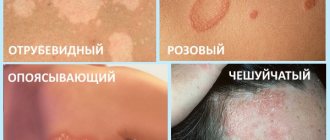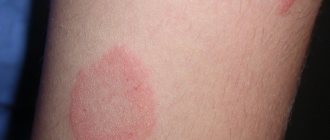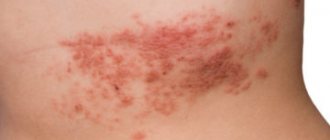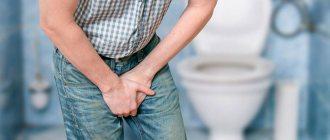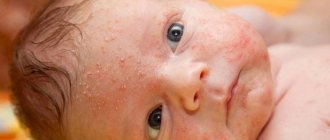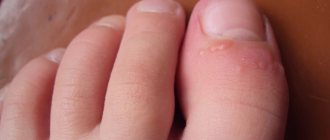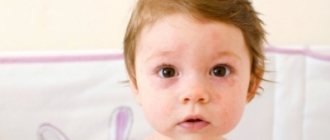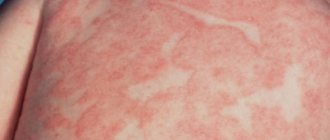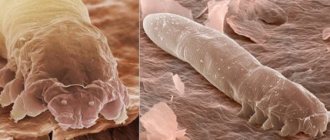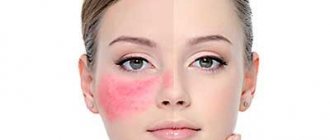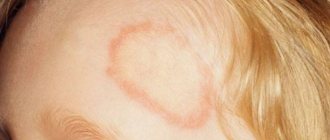The variety of skin diseases in humans is a serious problem in modern medicine. The adaptation of pathogens to drug therapy is increasing every day, and poor diet and harmful ecology have a detrimental effect on the immune system, reducing the body's resistance. Pet lovers are well aware of the problem of lichen. But when skin rashes appear on their face, many wonder: could it be cutaneous lichen and is it transmitted through contact with pets?
Attention! If a rash appears on the skin, accompanied by itching and peeling, visit a doctor immediately!
Ringworm on the face is a serious medical and cosmetic problem. In order to recognize lichen on the face, you need to know the causes of the pathology and the first signs of its appearance. Ringworm is an infectious disease, but not every person has skin lesions on the face. The secret is that our skin and mucous membranes are constantly inhabited by a huge number of bacteria, fungi and other microflora.
A healthy immune system provides constant protection against them, but when it is weakened, microbial agents can infect the skin and mucous membranes. Most often the causative agent is a fungal or viral infection. Some species can only be transmitted from domestic animals, for example, zooanthropophilic fungi that cause ringworm. Anthropophilic fungi and herpes viruses are transmitted only from person to person. Geophilic fungal infection lives in the soil and can infect humans and animals.
The main symptoms indicating lichen are the appearance of rashes on certain areas of the skin, characterized by redness, inflammation and peeling. Sometimes the symptoms are accompanied by weakness, malaise, and increased body temperature. Many people wonder how to recognize lichen and is it possible to get rid of the disease at home?
Important! Don't try to heal yourself! Ringworm has similar clinical signs to allergic rashes and some skin diseases. To make a diagnosis, consultation with a specialist is necessary.
Main manifestations
Ringworm on the face is an unaesthetic disease that affects a large number of blood vessels and nerve endings, spreads rapidly and worsens the patient’s well-being.
Patients complain that the following appears in the facial area:
- rashes in the form of spots or blisters;
- severe itching;
- swelling and hyperemia;
- peeling or weeping;
- erosion and pus;
- inflammation;
- low-grade fever up to 37.5-380C with enlarged submandibular lymph nodes.
Weeping
This disease has very characteristic symptoms. Among them it is worth highlighting:
- many small bubbles;
- often the rashes burst, which leads to the formation of erosions filled with serous fluid;
- after drying, erosions turn into crusts;
- severe burning, itching.
This is the most painful type of lichen, since the disease causes a strong feeling of discomfort, which does not allow the patient to rest normally.
Pathogens
Ringworm on the face is caused by fungal infections and herpes-like viruses.
There are three main types of parasitic fungi:
- Anthropophilic. Such fungi spread only on human skin. They are transmitted from an infected person to a healthy person through contact and household contact.
- Zooanthropophilic. The fungal infection lives on the skin and fur of domestic animals and is transmitted from them to the owner (or from a sick person).
- Geophilic. Lives in the soil. Defeat occurs when the rules of personal hygiene are insufficiently observed.
This whole “company” of pathogens is located in the body of children and adults without causing harm, but in order to cause lichen on the face they need a certain “push”.
Clinical picture
The first symptom of the pathological condition is the appearance of a rash on the face. Ringworm on the cheek is most common, but the rash can spread to the chin, forehead, temple area and even the neck. During the first few days the patient does not feel any discomfort. Then symptoms appear in the form of itching, peeling and redness of the skin around the spots. Sometimes the affected surface becomes covered with small blisters filled with clear liquid. They burst, leaving a wet surface in their place.
The patient's condition worsens, pain occurs when touched and when performing hygiene procedures, and the itching intensifies. In addition, other symptoms appear: increased body temperature, weakness, fatigue, joint and muscle pain, drowsiness, headache, loss of appetite.
With a long course of the pathological process, exhaustion of the body is observed. The spots spread to healthy areas, which aggravates the symptoms. When the patient scratches the area of inflammation, infection may occur and the lesion may become suppurated. Without treatment at this stage, the risk of blood poisoning increases.
Ringworm under the eye is especially dangerous, since the infection can get on the mucous membrane of the eye and cause conjunctivitis, as well as other pathologies of the visual system. Patients usually see a doctor on time, so such complications rarely develop.
Factors contributing to the development of lichen on the face
External:
- injury to the skin (cuts, scratches and abrasions), burns (thermal and chemical), as well as insect bites;
- parasitic diseases (worms, pediculosis);
- incorrect dosage of hormonal drugs and self-medication;
- failure to maintain personal hygiene (use of shared objects, cosmetics, underwear);
- environmental conditions (increased background radiation, long-term exposure to ultraviolet radiation or overdose of solarium procedures).
Internal:
- decrease in the body’s immune forces (poor nutrition, lack of vitamins, workaholism, harmful working conditions);
- heredity (structural features of the skin and sweat glands);
- disorders of the digestive system, failure of hormone production, diseases of the central and peripheral nervous system (diabetes, neurological diseases, stress, depression and mental illness, gastrointestinal disorders);
- chronic illnesses or acute infections (neoplastic tumors, tuberculosis, immunodeficiency, colds);
- allergies (food, household or cosmetic chemicals, paint, etc.).
What does lichen most often look like on the face?
There are quite a few types of lichen that like to live on the face.
Surface shearer
An extremely contagious disease. The first lesions appear on the 5th -10th day after contact with a sick person (or cat). Fungi such as Microsporum and Trichophyton are scattered mainly on the scalp under the hair; on the face they only affect the area bordering the hair and the chin.
The rashes are spots with clear outlines. The smooth edges of the rash are roller-shaped and bright pink in color. The border of the spot consists of small bubbles and papules. In the central part of the spots, the skin is pale yellow, but white or grayish scales are visible on it. As lichen develops, the spots increase in size and hardly itch.
It can become chronic only if the first manifestations are completely ignored and there is inaction.
It often occurs in children aged 4-15 years, when our children still play with unkempt cats. If lichen is not cured in time, it will become chronic and will torment the child until the end of adolescence.
Pink
The main cause of this type of lichen is a virus. The disease affects children after 4 years of age and up to 14 years, and adults up to 35 years of age.
Zhiber's lichen affects the skin of the shoulders, the back of the torso and thighs, and often the back. On the face, pityriasis rosea is found in the form of pale pinkish spots that are very itchy, flaky and cause a burning sensation.
In appearance, the rash closely resembles an allergic reaction and is therefore difficult to identify. The period of replacement of old spots with new ones varies from two to four weeks. The duration of the disease is from a month to one and a half.
Complications of lichen can cause the appearance of blisters with clear liquid, which are torn off due to constant scratching. In this case, a purulent infection enters the wounds, causing inflammation.
Pityriasis rosea on the face of a small child (under 2 years old) is practically not registered. The main risk group is children over 10 years of age.
Important! Having had pink lichen once, the body develops immunity, so there is no chronic form of Zhiber's lichen. But if there are problems with the immune system, the disease will still return.
Red flat
Typical places where a bright red rash appears on the face are the skin of the cheeks, chin, near the eyes and on the forehead. Weeping is visible inside the plaques. The course of lichen is accompanied by pain, severe itching (even at night), which leads to constant insomnia. More common in women.
Gradually, the mucous membranes of the oral cavity (cheeks and gums, palate and tongue) are involved in the process, causing additional troubles to the patient.
In children, lichen planus is a rare occurrence. Due to the fact that the loose skin of children contains more water than the body of an adult, and small blood vessels are located closer to the surface of the skin, swelling instantly forms, and the rash takes the form of nodules and purple blisters.
Pityriasis
Caused by the fungus Malassezia Furfur. People call this lichen “solar”. It is clearly visible when tanning, as it looks like small light spots that can unite into large lesions with signs of peeling and slight itching. The boundaries of the spots are clearly defined. The appearance of lichen is promoted by increased sweating and prolonged exposure to ultraviolet rays. It develops over a period of 2 weeks to 2-3 months and is chronic. Usually does not cause particularly unpleasant sensations.
Among the pediatric population, pityriasis versicolor occurs more often in schoolchildren and adolescents under 18 years of age. The development of the disease occurs within three weeks, but in babies under three years of age (a rare occurrence) quickly, in just a matter of days. On their face, the color of small spots varies from reddish to brownish shades with elements of peeling and a rounded shape. There is practically no pain or itching.
Weeping
Another name is eczema. It is characterized by a rapid onset with debilitating itching (even at night) and the appearance of paired lesions with the formation of vesicles (with serous contents). They merge into vesicles, burst when scratched, and weeping ulcers and burning occur. Then peeling, yellow crusts and cracks appear in their place. Inflamed and hyperemic lesions can fester.
The face is affected after direct exposure to the allergen on the skin of the face, necks and hands. If the cause of the allergy is not eliminated in time, eczema will become chronic.
In babies it appears on the forehead, behind the ears, on the head and neck. Most often, eczema “blooms” in children who are bottle-fed, since individually intolerable ingredients may be present in baby food.
girdling
The cause of the disease is the herpes zoster virus, which causes chickenpox. The second name for “sores” is herpes zoster. This is one of the most painful lichens and greatly worsens the overall well-being.
A small reddish rash, similar to chickenpox, spreads all over the body (including the face). The resulting itchy blisters with liquid inside measuring 0.3-0.5 cm burst and turn into crusts. Against the background of the rash, the temperature rises, chills, severe headache, and swelling appears. It hurts to touch the body. The disease is characterized by a long course.
With complications, this lichen leads to severe inflammatory processes in the internal organs.
In children, herpes zoster on the face affects not only the skin, but also organs innervated by the trigeminal nerve. Lymph nodes enlarge.
Psoriasis
It's also scaly lichen. Not contagious. Affecting a large part of the body, the facial area appears as very dry, red, raised papules. They are able to unite into plaques, inside of which whitish-gray and silvery “waxy” spots are formed.
On the face, psoriatic manifestations are pink spots, nodules, in place of which whitish scales appear over time. Tightness and dryness of the skin in the area of the temples, eyebrows, eyelids, between the forehead and hair, folds near the nose and wings of the nose, cheeks, and chin are noticeable.
Psoriasis on the face is very similar to seborrheic dermatitis, the only visible difference is the presence of a whitish film on the plaques, when removed, small droplets of blood appear.
Children suffer mainly from an atypical form, which is difficult to diagnose and causes the child, in addition to health problems, emotional inconvenience.
Important! If you suspect lichen on the face, you should immediately seek help from a dermatologist. Only a doctor can correctly diagnose the disease and prescribe complete therapy.
Prevention methods
All preventive measures aimed at preventing the occurrence of pityriasis rosea are aimed at strengthening the immune system and require compliance with the following recommendations:
- Maintain a healthy balanced diet, devoid of fast food.
- Avoid drinking alcohol and smoking, as bad habits are aimed at suppressing the immune system.
- Avoid tight underwear to avoid body chafing.
- Preference for underwear and bedding made from natural fibers.
- Fortification of the body, saturation with useful substances, macro- and microelements.
- Daily change of underwear and underwear followed by washing and ironing.
- Moderate exercise, walks in the fresh air.
- Minimizing stress and depression, providing for a full eight-hour sleep.
- Keeping the body clean.
In conclusion, I would like to say that pityriasis rosea is a dermatological disease of an infectious nature. Not contagious. Easily treatable, self-healing is possible. If you ignore the doctor’s recommendations or refuse treatment, it can lead to a decrease in immunity and the occurrence of a number of chronic diseases.
When choosing a traditional treatment method, a preliminary consultation with a specialist is recommended. If you follow preventive measures and a proper lifestyle, the occurrence of pityriasis rosea is almost impossible.
Diagnostics
To verify the correctness of the diagnosis, in addition to a visual examination and collection of patient complaints, the doctor prescribes laboratory tests. These include:
- blood test (general (the general condition of the patient is assessed) and sugar level (to exclude or confirm diabetes mellitus);
- sowing material collected from scales on spots (in a bacteriological laboratory)
- scraping of skin particles (for examination under a microscope).
- Wood's lamp examination;
- Balser's test using 5% iodine tincture;
- allergy test.
How to treat lichen on the face
Treatment of any type of lichen on the face involves both getting rid of the cause of the disease and the symptoms.
General measures for the treatment of all types of lichen can be considered:
- antifungal and antiviral drugs;
- antibiotics (erythromycin, penicillin, ampicillin, gentomycin, tetracycline);
- vitamins (groups B, A, D, C and E);
- antiallergic (tablets - tavegil, suprastin, loratadine, diazolin);
- hormonal (ointments - flucinar, lorinden, sinalar, prednisolone, betamethasone, polcortolone, oxycort).
Private treatment methods are presented in the table:
| Disease | Drug and method of administration |
| Shearing superficial | If eyelashes and eyebrows are affected, they need to be plucked. Then an alcohol solution of 0.2% brilliant green (brilliant green) is carefully distributed along the edge of the eyelid. Then an ointment, cream or spray is applied, the main component of which is intraconazole (orungal, itracon) and terbinafine (lamisil, exifin) (for a month and a half). In complicated cases, griseofulvin is prescribed in tablets at the rate of 22 mg per kilogram of body weight. |
| Pink | Here you need acyclovir (200 mg 5 times a day), which is taken orally for 5 days (all except one-year-old children). Salicylic ointment is effective for treating lesions (twice a day). A combination of sulfur ointment and pharmaceutical birch tar, a teaspoon of each (morning and evening), will relieve inflammation. |
| Red flat | Absolutely necessary: hormonal ointments applied two to three times a day (reaferon), vascular preparations (tablets - xanthinol, trental), sedatives in tablets (diazepam), regenerating (solcoseryl ointment), exfoliating (belosalik), antibiotics. Physiotherapy has a positive effect: laser, magnetic and PUVA therapy. |
| Pityriasis | Shampoos for washing the body and face - sulsen and nizoral - with simultaneous intake of fluconazole capsules (three times a day), ointments with zinc and salicylic acid are remarkably helpful. |
| Weeping | In this case, lichen is of particular importance in relieving allergy symptoms with the help of intravenous administration of saline. solution with calcium and magnesium preparations, taking activated carbon tablets. In addition, the following are suitable: baths with sea salt and medicinal mud; cryotherapy; paraffin wraps; medicinal teas and herbal baths; laser treatment. |
| girdling | Acyclovir or famciclovir is used according to the instructions (both in injections and tablets) for a week. Be sure to take painkillers - analgin, ibuprofen. |
| Psoriasis | Cytostatics (cyclosporine) and drugs containing vitamin A - retinol, (isotretinoin), anti-inflammatory, antipruritic, antiallergic ointments (flumethasone, triamcinolone) are taken. Diet and physical therapy are of great importance. |
Treatment of pityriasis versicolor, multicolored lichen in humans
Tinea versicolor responds well to treatment with ultraviolet rays, so in the summer you should sunbathe, and the affected areas become discolored, which lasts for several months.
As well as with ringworm, oral antimycotic drugs are used to treat pityriasis versicolor in humans - Lamisil (Brmisil, Terbinox, Terbizil, etc. with the active ingredient terbinafine), Nizoral - (Fungavis, Mycozoral, etc. with the active ingredient Ketoconazole), Orungal - (Rumikoz, Irunin, Itrazol, etc., with the active ingredient Itraconazole).
Local antifungal agents include Mikospor, Bifosin, as well as various shampoos, ointments, solutions, creams with Clotrimazole and Nizoral.
Salicylic lotion with chamomile is also effective. It is better to use complex prescription drugs, such as Vidal's milk , which is made according to a prescription in pharmacies. The composition of Vidal's milk includes salicylic acid, camphor, alcohol, boric acid, glycerin, and sulfur lotion; a doctor prescribes a prescription for its production.
There is also a prescription Lassara paste , which has a drying and anti-inflammatory effect; it contains starch, salicylic acid, petroleum jelly, and zinc oxide.
Read more about the symptoms and treatment of tinea versicolor in our article.
Diet
In order to cure lichen on the face as quickly as possible, you need to adhere to a thermally, mechanically and chemically gentle diet.
The diet should include boiled or stewed lean meat and fish, a variety of vegetables and fruits (but not citrus fruits), dairy and fermented milk products, and herbs. But you will have to say goodbye to chocolate, sweet, sour, highly salted, spicy, smoked, coffee and flour. Stop smoking and alcohol.
Traditional medicine recipes at home
- Sea buckthorn oil. The oil purchased at the pharmacy is applied to the affected areas of the skin twice a day. The product heals and relieves pain well, promotes the growth of new clean skin cells.
- A series. An infusion is prepared that soothes inflammation and relieves itching. Dried string flowers (1 tbsp) are brewed with a glass of boiling water. Leave in the wrapped container for an hour. Warm infusion is applied to the affected areas of the skin.
- Decoction for washing. Made from pine needles, celandine and yarrow herbs, as well as chamomile flowers and oak bark. All herbs are boiled in a tablespoonful for 20 minutes in a water bath in a liter of water over low heat. Bring to a comfortable temperature and wash two to three times a day.
- Herbal tea made from chamomile and string flowers, sage leaves and lemon balm. A liter of boiling water is poured into the collection (1 tablespoon of each herb) and, wrapped, left to steep for 40-50 minutes. Drink 2-3 times a day instead of tea.
Traditional recipes can be used not only to speed up the treatment of the disease, but also to prevent it (prophylaxis).
